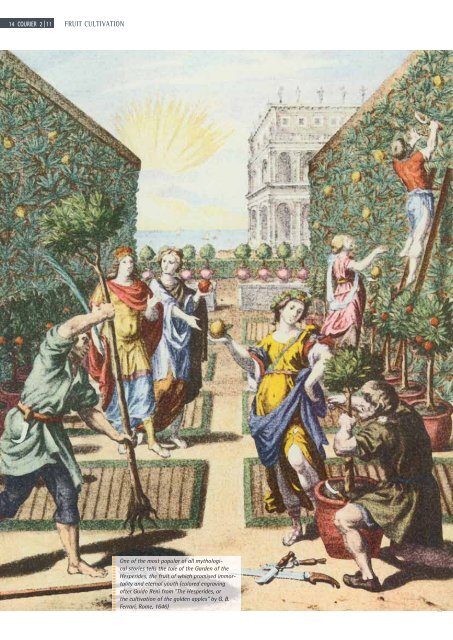COURIER
You also want an ePaper? Increase the reach of your titles
YUMPU automatically turns print PDFs into web optimized ePapers that Google loves.
14 Courier 2 | 11 fruit Cultivation<br />
fruit Cultivation 2 | 11 Courier 15<br />
Cultural history of Citrus<br />
The Golden Apples<br />
of the Hesperides<br />
These days, people eat more citrus fruits than bananas or apples.<br />
That wasn’t always the case – particularly in the europe of yesteryear.<br />
One of the most popular of all mythological<br />
stories tells the tale of the Garden of the<br />
Hesperides, the fruit of which promised immortality<br />
and eternal youth (colored engraving<br />
after Guido Reni from “The Hesperides, or<br />
the cultivation of the golden apples” by G. B.<br />
Ferrari, Rome, 1646)<br />
Fifteen lemons and seven<br />
oranges. This selection could find its<br />
way into the shopping basket during any<br />
trip to the supermarket. But it was an<br />
exotic catch in the England of 1289. The<br />
fruits arrived at Portsmouth on board a<br />
Spanish ship – and then went directly to<br />
the Royal Court. They were apparently<br />
intended to comfort Eleanor of Castile,<br />
King Edward the First’s queen, to help<br />
her overcome her homesickness for her<br />
native Spain. But it would be a good few<br />
hundred years before the common English<br />
populace could enjoy citrus fruits.<br />
Until comparatively recently, citrus<br />
fruits were considered something special<br />
in a large part of the world – symbols of<br />
luxury and riches. So it’s not surprising<br />
that a fashion developed among European<br />
princes during the Baroque era to<br />
create orangeries – exotic fruit gardens<br />
that served mainly to demonstrate affluence.<br />
It was also around that time that the<br />
term “Hesperides” started to be applied<br />
to the fleshy berry fruits with a leathery<br />
peel. Botanists such as Carl von Linné<br />
and Giovanni Baptista Ferrarius helped<br />
to establish the term, which was a reference<br />
to Greek mythology, according to<br />
which the daughters of Atlas – the Hesperides<br />
– had the job of tending a golden<br />
apple tree whose fruits gave the Gods<br />
nothing less than eternal youth. Ferrarius<br />
and Linné were obviously reminded<br />
of the golden apples of the Hesperides<br />
by citrus fruits’ bright appearance. And<br />
this is how the name came to be used in<br />
connection with parks with citrus fruit<br />
groves, such as the Garden of the Hesperides<br />
in Nuremberg.<br />
Long before people learned to appreciate<br />
the culinary value of citrus fruits,<br />
they were being used for the scent of<br />
their essential oils. Take for example<br />
eau-de-cologne – the recipe for which<br />
has included Bergamot orange right<br />
from the beginning. Citrus fruits were<br />
also used in medicine and as protection<br />
against insects.<br />
It was during the 17th century that the<br />
edible, sweet citrus fruits first became<br />
widely available. One of the main beneficiaries<br />
was the shipping community.<br />
James Cook is supposed to have been<br />
the first to bring the fruit (with its high<br />
vitamin C content) on board, in order to<br />
protect his crew from scurvy.<br />
At some point then, citrus fruits began to<br />
be recognized as the tasty food item we<br />
know them as today. And they continue<br />
to grow in popularity. Global production<br />
has increased nearly six-fold over the<br />
last 50 years. According to the FAO, 25<br />
million tonnes were harvested globally<br />
in 1961: in 2009, the corresponding figure<br />
was more than 120 million tonnes,<br />
sixty-eight million tonnes of which was<br />
oranges. This shows that citrus fruits<br />
are now well to the fore of bananas (97<br />
million tonnes) and apples (71 million<br />
tonnes).<br />
However, like other agricultural products,<br />
the citrus harvest isn’t something<br />
that can be taken for granted. Citrus<br />
farmers have to deal with various potential<br />
sources of damage to their crops.<br />
One particularly problematic factor on<br />
the American continent at the moment<br />
is the Huang long bing disease (see page.<br />
18). Because no products are available<br />
yet to control the deadly causal agent<br />
directly, the only option left is to control<br />
the vector. Here, Bayer CropScience<br />
is able to offer considerable support<br />
to both professional growers and private<br />
gardeners. A major contributor is<br />
the new insecticide Movento®, which<br />
is becoming an increasingly important<br />
tool for citrus farmers around the<br />
world (see page 16). Another product<br />
has been at the centre of an interesting<br />
pilot study involving the participation<br />
of citrus farmers in Spain: this is Decis®<br />
Trap, which was used for the first time<br />
in an effort to control the Mediterranean<br />
fruit fly. The advantage here is that the<br />
active substance no longer needs to be<br />
sprayed. Instead, it is used in the traps,<br />
towards which the flies are persuaded to<br />
move, enticed by a suitable attractant<br />
(see page 03).<br />
But back to history: although things<br />
have changed significantly over recent<br />
centuries, there is still no professional<br />
citrus growing on the British Isles today.<br />
But for all that, the United Kingdom is<br />
among the ten largest importers of citrus<br />
fruits in the world. Nearly 44,000 tonnes<br />
of grapefruit, 100,000 tonnes of lemons<br />
and limes, 275,000 tonnes of mandarins<br />
and 300,000 tonnes of oranges were<br />
imported into the British Isles in 2008.<br />
This is all on a rather larger scale than<br />
the 22 fruits presented to Queen Eleanor<br />
in 1298. t



